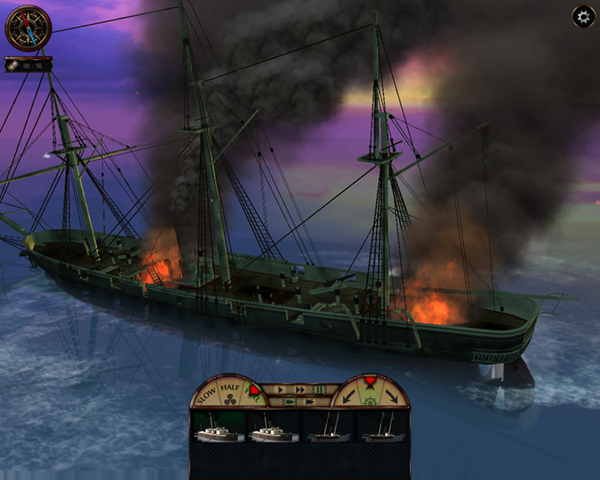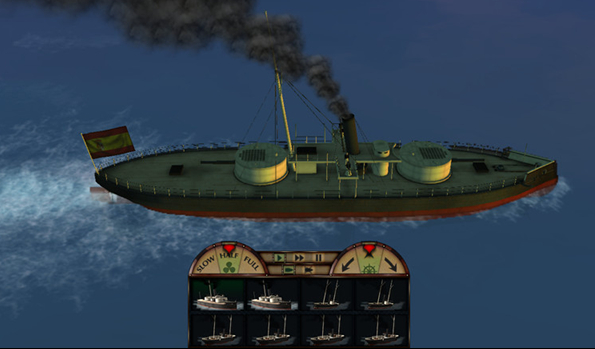Victorian Admirals: Anthology – PC Game Review
 Victorian Admirals: Anthology. PC Game Review. Publisher: Totem Games. Developer: Totem Games. $29.99
Victorian Admirals: Anthology. PC Game Review. Publisher: Totem Games. Developer: Totem Games. $29.99
Passed Inspection: Great graphics, good AI, improved mechanics, interesting period.
Failed Basic: Lack of customization, rigidity of scenarios, no multiplay, limited replay.
Totem games continues to enlighten us about late-19th-century naval matters after giving us a look at the American Civil War, the Schleswig-Holstein dust-up, the Chincha Islands War between Spain, Peru, and Ecuador, and a hypothetical action between Russia and Britain. Victorian Admirals looks at the 1880s when two Johnny-Come-Latelys to imperialism, Imperial Germany and the US, snarled at each other and doddering Spain over the remaining territories to grab. The four clashes portrayed never ended in shooting but the parties concerned certainly rattled sabers and tensions were high.
{default}The Tried and True
Victorian Admirals continues the series’ hallmarks. The ships of the period, transitional models between the graceful sailing ships of the early 19th century and the sleek cruisers exemplified by the USS Olympia of Dewey’s fleet, are portrayed in detail. Many vessels look like Nelsonian frigates with a smokestack. Others are simply strange. Turret ships appear to have two pillboxes fore and aft with a gun protruding from them. Casemate ships and some cruisers are slab-sided beasts with no grace but some real armor. Beauty tends to lose in these engagements. Each ship has its displacement, armor, speed, and armament shown in the scenario briefing while current speed, fire damage, and flooding are seen as percents in battle. The physics of speed and movement are accurate with time lags for course and speed changes. Hull damage is shown with scorch marks, but stacks and spares remain intact even as a doomed ship slowly slips under the waves. Fires rage dramatically.

A raging fire.
Environmental effects are splendid. Scenarios take place in the Pacific or the Caribbean, so players are treated to glass-like seas and stunning sunsets. Smoke is persistent and wakes bubble realistically. Cannon fire belches smoke, and hits are seen as distant flashes. Mouse and keyboard controls allow views from any distance and angle. Sound effects include the blast of armament, crackle of fire and throb of engines.
The three-page PDF manual is a bit disappointing. Game play is explained well and a table shows accuracy, penetration, rate of fire and relative level of damage inflicted by each gun type. However, more detail on the ship classes for each country and references to the crises would have been welcome.
Limited Engagement
Action takes place in these four settings:
Caroline Island Crisis – 1885 (Spain vs. Germany)
Panama Crisis – 1885 (Chile vs. US)
Marianas Incident – 1887 (Spain vs. US)
Samoan Crisis – 1889 (Germany vs. US)
Some aspects of play are identical to the older games. Ships are in two columns with a maximum of four ships per column. Players only control the speed and course of the lead ship, so the column always turns in succession and has its speed limited to the slowest vessel. Ships automatically fire at the closest enemy, limiting player control to opening or ceasing fire per ship. This ability comes in most handy when ships keep firing at sinking opponents, wasting time and letting other targets flee. Badly damaged ships break off independently and head for the boundary of the battle area. If they make it out, they will return the next day to carry on the fight.

The simplified ship controls are an improvement.
Ship handling has been improved through simplification. Instead of clicking on tiny points on a spectrum from hard-to-port and hard-to-starboard but then clicking in the middle to steady on course, players simply choose port and starboard and then amidships when the desired course has been attained. Speed is simple: slow, half, and full. Reverse has been eliminated because it created too many collisions in the column. While the absence of reverse does make columns easier to handle, collisions with enemy ships are resolved only through time.
The most conspicuous change from previous games is ship selection – rather the absence thereof. Older products allowed players to “buy” ships and arrange them in columns to taste. In Victorian Admirals, what players see is what they get. The order of battle for each scenario is set by the developers, down to column composition. The customization option that allowed players to compare ship types in one-on-one matches is absent. The option to pick difficulty levels is also gone.
The scenarios are not remotely balanced. One side will always be outnumbered and outclassed in terms of ship types; one side will have unarmored ships against a few ironclads. These matchups are not as bad as they appear. The older vessels usually have heavy broadsides that can devastate even an ironclad. By the same token, turret ships do not have the weight of fire of a broadside.
Players, then, must use the advantages they have. Battles start with each side’s two columns sailing toward each other from a distance, giving players plenty of time to position their forces, e.g. moving a weak column behind the strong one. If the AI has the stronger fleet, it’ll try for a slugfest. Players should, therefore, try to nip at the smaller enemy vessels, whittle numbers down and then head for the boundary or run out the clock to return next day with better odds. Strangely, the uneven nature of the battles assures the replayablity of the game.
Summing up Victorian Admirals is difficult. The ships are fascinating and the scenarios interesting. The AI is canny and the UI is much improved. Unfortunately, the decision not to implement the ability to customize fleets removes some of the charm of the game. Totem Games should be urged to put it back in with an add-on while keeping the original scenarios.
Armchair General Rating: 78%
About the Author
Jim Cobb has been playing board wargames since 1961 and computer wargames since 1982. He has been writing incessantly since 1993 to keep his mind off the drivel he dealt with as a bureaucrat. He has published in Wargamers Monthly, Computer Gaming World, Computer Games Magazine, Computer Games Online, CombatSim, Armchair General, Subsim, Strategyzone Online.

